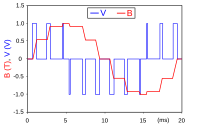
Photo from wikipedia
Identifying and scoring arousals are crucial to score hypopneas and respiratory efforts related arousals (RERAs). At the same time, children’s sleep architecture appears to be more stable compared to adults… Click to show full abstract
Identifying and scoring arousals are crucial to score hypopneas and respiratory efforts related arousals (RERAs). At the same time, children’s sleep architecture appears to be more stable compared to adults which makes it more difficult to score arousals. Pulse wave amplitude (PWA) is a signal obtained from finger photoplethysmography which is directly and positively correlated to finger blood flow. It is also used as a marker for finger vasoconstriction reflected by decreased signal amplitude and as a surrogate for autonomic and cortical arousals. Our aim was to study the effect of scoring arousals based on PWA on scoring of respiratory events in pediatric patients. Ten polysomnograms for patients between the ages of 5-15 years who had apnea-hypopnea indices between 1 and 3 events/hour were identified. Patients with syndromes were excluded. A drop in PWA signal of at least 30% that lasted for 3 seconds was needed to identify subcortical/autonomic arousals. Arousals were rescored based on this criteria and subsequently respiratory events were rescored. Paired t-tests were employed to compare PSG indices scored with or without PWA incorporation. The sample of 10 children included 2 females, and the average age was 9.8 +/-3.1 years. Overall, polysomnography revealed an average total sleep time of 464.1 +/-25 mins, sleep efficiency of 92% +/-4.2, sleep latency of 19.6 +/-17.0 mins, rapid eye movement (REM) latency 143 +/-66 mins, N1 3.9% +/-2.0, N2 50.3% +/-12.0, N3 28.2% +/-9.1, REM 16.7% +/-4.0, and wakefulness after sleep onset (WASO) 18.1 +/-7.5 mins. Including arousals from PWA changes, respiratory indices significantly increased including total AHI (2.3 +/-0.7 vs 5.7 +/-2.1, p<0.001), obstructive AHI (1.45 +/-0.7 vs 4.8 +/-1.8, p<0.001), and RDI (2.36 +/-0.7 vs 7.6 +/-2.0, p<0.001). Likewise, total arousal index was significantly higher (8.7 +/-2.3 vs 29.4 +/-6.5, p<0.001). Pulse wave amplitude is a useful marker for arousals that are not otherwise easily identified in pediatric polysomnography. This in turn would lead to a more accurate scoring of respiratory events and severity assessment of sleep disordered breathing. This likely will have clinical and therapeutic implications. None
Journal Title: Sleep
Year Published: 2020
Link to full text (if available)
Share on Social Media: Sign Up to like & get
recommendations!